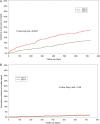Causes-of-death analysis of patients with cardiac resynchronization therapy: an analysis of the CeRtiTuDe cohort study
- PMID: 26330420
- PMCID: PMC4628644
- DOI: 10.1093/eurheartj/ehv455
Causes-of-death analysis of patients with cardiac resynchronization therapy: an analysis of the CeRtiTuDe cohort study
Abstract
Aims: The choice of resynchronization therapy between with (CRT-D) and without (CRT-P) a defibrillator remains a contentious issue. Cause-of-death analysis among CRT-P, compared with CRT-D, patients could help evaluate the extent to which CRT-P patients would have additionally benefited from a defibrillator in a daily clinical practice.
Methods and results: A total of 1705 consecutive patients implanted with a CRT (CRT-P: 535 and CRT-D: 1170) between 2008 and 2010 were enrolled in CeRtiTuDe, a multicentric prospective follow-up cohort study, with specific adjudication for causes of death at 2 years. Patients with CRT-P compared with CRT-D were older (P < 0.0001), less often male (P < 0.0001), more symptomatic (P = 0.0005), with less coronary artery disease (P = 0.003), wider QRS (P = 0.002), more atrial fibrillation (P < 0.0001), and more co-morbidities (P = 0.04). At 2-year follow-up, the annual overall mortality rate was 83.80 [95% confidence interval (CI) 73.41-94.19] per 1000 person-years. The crude mortality rate among CRT-P patients was double compared with CRT-D (relative risk 2.01, 95% CI 1.56-2.58). In a Cox proportional hazards regression analysis, CRT-P remained associated with increased mortality (hazard ratio 1.54, 95% CI 1.07-2.21, P = 0.0209), although other potential confounders may persist. By cause-of-death analysis, 95% of the excess mortality among CRT-P subjects was related to an increase in non-sudden death.
Conclusion: When compared with CRT-D patients, excess mortality in CRT-P recipients was mainly due to non-sudden death. Our findings suggest that CRT-P patients, as currently selected in routine clinical practice, would not potentially benefit with the addition of a defibrillator.
Keywords: Cardiac resynchronization; Cardioverter defibrillator; Competing risk; Heart failure; Sudden death.
© The Author 2015. Published by Oxford University Press on behalf of the European Society of Cardiology.
Figures


Comment in
-
Cause of death and CRT device selection: striving for certitude?Eur Heart J. 2015 Nov 1;36(41):2777-9. doi: 10.1093/eurheartj/ehv474. Epub 2015 Sep 15. Eur Heart J. 2015. PMID: 26374850 No abstract available.
References
-
- Effect of metoprolol CR/XL in chronic heart failure: Metoprolol CR/XL Randomised Intervention Trial in Congestive Heart Failure (MERIT-HF). Lancet 1999;353:2001–2007. - PubMed
-
- Bardy GH, Lee KL, Mark DB, Poole JE, Packer DL, Boineau R, Domanski M, Troutman C, Anderson J, Johnson G, McNulty SE, Clapp-Channing N, Davidson-Ray LD, Fraulo ES, Fishbein DP, Luceri RM, Ip JH, Sudden Cardiac Death in Heart Failure Trial I. Amiodarone or an implantable cardioverter-defibrillator for congestive heart failure. N Engl J Med 2005;352:225–237. - PubMed
-
- Cleland JG, Daubert JC, Erdmann E, Freemantle N, Gras D, Kappenberger L, Tavazzi L, Cardiac Resynchronization-Heart Failure Study Investigators. The effect of cardiac resynchronization on morbidity and mortality in heart failure. N Engl J Med 2005;352:1539–1549. - PubMed
-
- Linde C, Leclercq C, Rex S, Garrigue S, Lavergne T, Cazeau S, McKenna W, Fitzgerald M, Deharo JC, Alonso C, Walker S, Braunschweig F, Bailleul C, Daubert JC. Long-term benefits of biventricular pacing in congestive heart failure: results from the MUltisite STimulation in cardiomyopathy (MUSTIC) study. J Am Coll Cardiol 2002;40:111–118. - PubMed
-
- Gold MR, Linde C, Abraham WT, Gardiwal A, Daubert JC. The impact of cardiac resynchronization therapy on the incidence of ventricular arrhythmias in mild heart failure. Heart Rhythm 2011;8:679–684. - PubMed
Publication types
MeSH terms
LinkOut - more resources
Full Text Sources
Other Literature Sources
Medical
Research Materials

